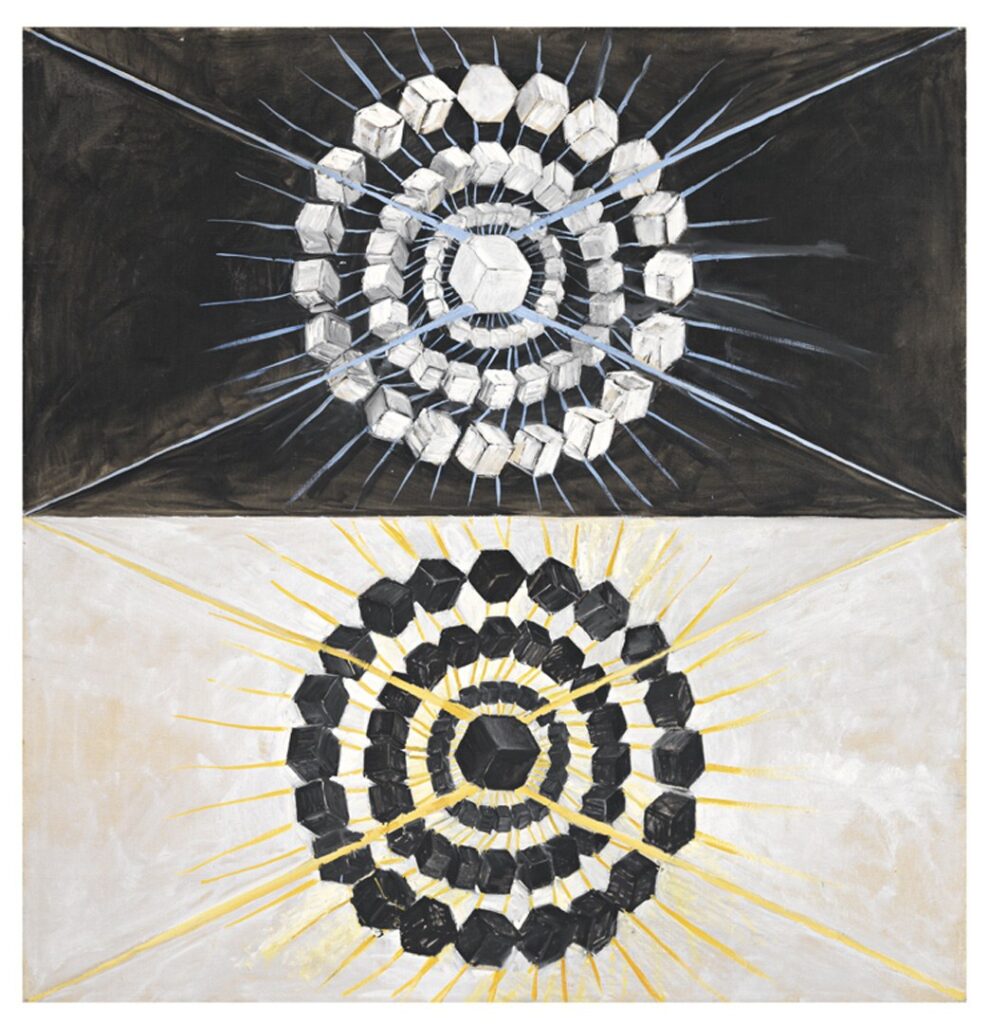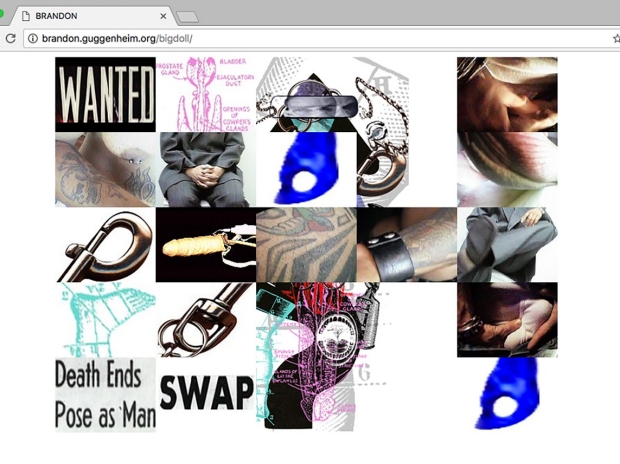I’m primarily interested in the VR and the ‘atoms’ of Swedish artist Hilma af Klint but first there are the NFT (non-fungible tokens). From an October 28, 2022 article by Louis Jebb for The Art Newspaper,
More than a century after she completed her chef d’oeuvre—193 abstract canvases known collectively as Paintings for the Temple (1906-15)—Hilma af Klint has emerged this year as a multimedia power player. Her work—graphic, colourful and deeply idiosyncratic—has demonstrated a Van Gogh-like power to generate footfall and has given rise to projects across multiple formats, from books and films to experiences in virtual and augmented reality (VR/AR).
Now, from 14 November [2022], digital versions of all 193 of her Paintings for the Temple, created by Acute Art, will be offered as NFTs in one edition, for sale on Goda (Gallery of Digital Assets), the platform launched earlier this year by the multi-Grammy award-winning philanthropist and recording artist Pharrell Williams. A second edition of the NFTs will remain with Bokförlaget Stolpe, the publishers of the Af Klint catalogue raisonée. The originals belong to the not-for-profit Hilma af Klint Foundation in Sweden.
“Hilma af Klint was an incredible pioneer!” says Pharrell Williams. “It took us a century to fully understand. Now that we do, we need to rewrite art history! Beautiful and meaningful art truly transcends time, and Hilma af Klint’s work is a perfect example of that. We’re honoured to show her work on this platform and to truly celebrate a remarkable woman.” For KAWS, who acts as an art adviser on the Goda platform, Af Klint was a visionary. “I find it great that she finally gets the attention she deserves,” KAWS says. “During her lifetime the audience wasn’t ready but today we are. She painted for the future. She painted for us!”
…
VR
Hilma af Klint dreamt of a spiral shaped building to house her most important work, but the idea never materialised. More than a century later, af Klint’s vision has been translated into a VR experience where some of her most important paintings come alive. Hilma af Klint – The Temple is produced in collaboration with [Bokförlaget Stolpe and] Acute Art and premiered at Koko Camden during the Frieze Art Fair 2022. The virtual reality work Hilma af Klint – The Temple is a 12-minute VR experience which includes 193 of Hilma af Klint’s paintings in a format that transcends time and space and makes a significant portion of her artistic output available to the public.
Hilma af Klint – The Temple VR was on tour since it first debuted in 2022 and Elissaveta M. Brandon wrote up her experience in New York City in a October 25, 2023 article for Fast Company, Note: Links have been removed,
It is noon on a Tuesday, and I am sitting in a cocktail bar. But instead of a Negroni on my table, there is a VR headset.
The reason for this anomaly dates back to 1915, when the Swedish artist Hilma af Klint completed a series of paintings titled, Paintings for the Temple. The artist died in 1944, but from the 124 notebooks she left behind, we know that she dreamed of housing these paintings in a spiral-shaped building known as the Temple.
That building never materialized in real life, but it has now—in virtual reality.
Af Klint, which The Art Newspaper has described as “the mystic Swedish mother of early-modern abstraction,” is having a bit of a moment. A museum dedicated solely to her work remains to be built, but over the past few years, the artist has been the subject of a sprawling exhibition at the Guggenheim, a biopic, a new biography, a catalogue raisonné (a comprehensive, annotated list of all known works by the artist), an augmented reality “art walk” in London’s Regent’s Park, and now, a virtual reality temple.
The VR experience—I lack the words to describe it in any other way—is titled, Hilma af Klint: The Temple and lasts 12 minutes. It was conceived by the London-based extended-reality studio Acute Art in collaboration with [Bokförlaget] Stolpe Publishing. After various stints at the Tate Modern in London, the Institut Suédois in Paris, and Bozar in Brussels, it has now arrived at the Fotografiska Museum in New York City, where it is on view until November 19 [2023], inside a cocktail bar, which is tucked away behind a door in the museum’s lobby, and fittingly called Chapel Bar.
The artist left behind a large body of abstract work inspired by her spiritual encounters. Her series, Paintings for the Temple, was, in fact, born out of a séance, during which she was asked to take on a more extensive project than her previous work. Paintings for the Temple took 9 years to complete; it took me 12 minutes to explore.
…
Atoms
While the focus is usually on af Klint’s spirituality and her absence from art history, there’s also her interest in science, from Brandon’s October 25, 2023 article,
…, I wonder how af Klint would have felt about her paintings being presented in virtual reality. According to Birnbaum [Daniel Birnbaum, current director and curator of Acute Art], who is the former director of Moderna Museet, Sweden’s museum of modern art in Stockholm, af Klint had a scientific mind. “One wonders what she would have thought of computation and recent inventions, like the blockchain,” he says. Stolpe also points me to the artist’s Atom Series—the atom being a major theme during her lifetime.

The Guggenheim Museum in New York still has material from its 2018 blockbuster Hilma af Klint show available online, including this October 24, 2018 combined audio/transcript article, which includes these tidbits in the transcript,
The Atom Series (1917) by Hilma af Klint
…
Tracey Bashkoff [Director of Collections and Senior Curator at the Guggenheim]: Hilma af Klint is working at a time where the most recent scientific discoveries show that there is a world beyond our observable world, and that things like atoms and sound waves and x-rays and particles exist, that we don’t observe with the naked eye. And so, the question of opening up an invisible world from our physical world, being able to make observations of another dimension of reality, becomes an issue of exploration for af Klint and for many of the thinkers of her time.
Narrator: These works are from The Atom Series, which was executed in 1917. The atom was a major theme in science and society at large during the artist’s lifetime. In the last five years of the 19th century, the accepted understanding of atoms was overturned by the discovery of subatomic particles. At the same time, scientists were making numerous discoveries about electromagnetism, x-rays, radioactive decay, and other phenomena.
The audio file is about 2 mins. long and it’s a short transcript.
Follow up
Sadly, the VR show in New York City does not seem to have been extended and I can’t find any information about future ‘tour’ stops but I have found websites for Acute Art, Bokförlaget Stolpe Publishing, and Fotografiska New York.
